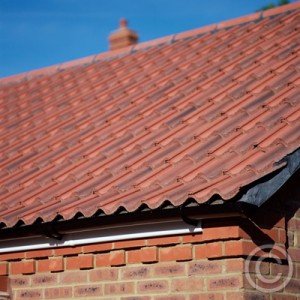Pros and Cons of Tile Shingles
 Figuring out the best material for roofing your home is well worth the time you spend researching your options. There are so many factors to consider: cost, longevity, supplemental redesign, weather, and of course, appearance. The best place to start is with a good look at some of the alternatives available to you.
Figuring out the best material for roofing your home is well worth the time you spend researching your options. There are so many factors to consider: cost, longevity, supplemental redesign, weather, and of course, appearance. The best place to start is with a good look at some of the alternatives available to you.
Asphalt tile — This is the most common roofing material around. These shingles are inexpensive and easy to replace or repair. Standard asphalt shingles can last from 15-20 years; you can also choose from a large array of weights, colors, durability levels, styles, and sizes. These shingles are available in organic (paper-based) or fiberglass. Fiberglass are a better choice in terms of fire ratings; they are usually Class A. Paper-based shingles, by contrast, can only manage a Class B rating, and that’s only if they are of superior quality. Otherwise, a Class C rating is more common. The fiberglass shingles are the most popular choice between the two versions, largely because of their safety ratings and their longevity. The biggest downside is that the material will degrade over time and will likely need to be replaced, which is a cost that needs to be figured into your roofing choice.
Concrete tile — Generally composed of cement, sand, and water, concrete is a good choice for a long lifespan ( up to 50 years), and can easily maintenance sturdiness. This material also comes in a variety of colors, styles, and finishes, which can contribute to the uniqueness of your home. Like fiberglass tile, concrete tile garners a Class A fire-rating and has the added advantage of sound insulation. Concrete tiling will cost more and is also subject to weathering, though not as rapidly as asphalt tiles.
Slate — Of all the roofing materials available, slate has the best pedigree. It is commonly used in historic building renovations, and has unmatched durability (up to 200 years). Slate is waterproof and requires little maintenance. As with clay tile, slate is a very heavy material, and may require extra roof support, which means more expenses. Slate can also be breakable and requires professional installation.
Clay tile — The main benefits of this type of roofing material include lifespan, fire-protection, and beauty. The biggest downside is that clay tile is a very heavy material, so it is often necessary to augment the roof support system to handle the extra weight. This will also result in additional costs for your roofing project. Another consideration is that tile is so durable that it may outlive the substrate it is placed on, which could mean a difficult and expensive renovation. Still, like slate, it is one of the most beautiful and time-honored materials available for creating a stylish roof that has tons of curb appeal.
